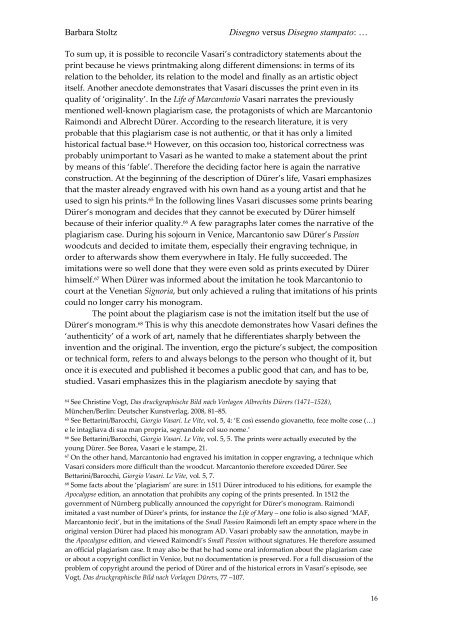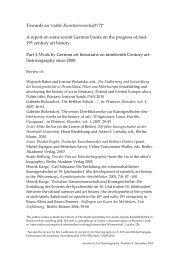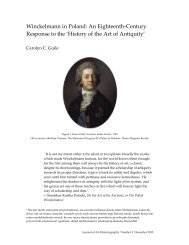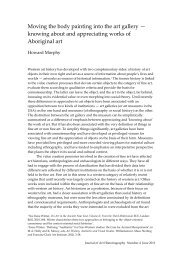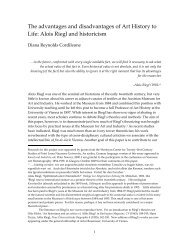7-BS/1 - Journal of Art Historiography
7-BS/1 - Journal of Art Historiography
7-BS/1 - Journal of Art Historiography
Create successful ePaper yourself
Turn your PDF publications into a flip-book with our unique Google optimized e-Paper software.
Barbara Stoltz Disegno versus Disegno stampato: …<br />
To sum up, it is possible to reconcile Vasari’s contradictory statements about the<br />
print because he views printmaking along different dimensions: in terms <strong>of</strong> its<br />
relation to the beholder, its relation to the model and finally as an artistic object<br />
itself. Another anecdote demonstrates that Vasari discusses the print even in its<br />
quality <strong>of</strong> ‘originality’. In the Life <strong>of</strong> Marcantonio Vasari narrates the previously<br />
mentioned well-known plagiarism case, the protagonists <strong>of</strong> which are Marcantonio<br />
Raimondi and Albrecht Dürer. According to the research literature, it is very<br />
probable that this plagiarism case is not authentic, or that it has only a limited<br />
historical factual base. 64 However, on this occasion too, historical correctness was<br />
probably unimportant to Vasari as he wanted to make a statement about the print<br />
by means <strong>of</strong> this ‘fable’. Therefore the deciding factor here is again the narrative<br />
construction. At the beginning <strong>of</strong> the description <strong>of</strong> Dürer’s life, Vasari emphasizes<br />
that the master already engraved with his own hand as a young artist and that he<br />
used to sign his prints. 65 In the following lines Vasari discusses some prints bearing<br />
Dürer’s monogram and decides that they cannot be executed by Dürer himself<br />
because <strong>of</strong> their inferior quality. 66 A few paragraphs later comes the narrative <strong>of</strong> the<br />
plagiarism case. During his sojourn in Venice, Marcantonio saw Dürer’s Passion<br />
woodcuts and decided to imitate them, especially their engraving technique, in<br />
order to afterwards show them everywhere in Italy. He fully succeeded. The<br />
imitations were so well done that they were even sold as prints executed by Dürer<br />
himself. 67 When Dürer was informed about the imitation he took Marcantonio to<br />
court at the Venetian Signoria, but only achieved a ruling that imitations <strong>of</strong> his prints<br />
could no longer carry his monogram.<br />
The point about the plagiarism case is not the imitation itself but the use <strong>of</strong><br />
Dürer‘s monogram. 68 This is why this anecdote demonstrates how Vasari defines the<br />
‘authenticity’ <strong>of</strong> a work <strong>of</strong> art, namely that he differentiates sharply between the<br />
invention and the original. The invention, ergo the picture’s subject, the composition<br />
or technical form, refers to and always belongs to the person who thought <strong>of</strong> it, but<br />
once it is executed and published it becomes a public good that can, and has to be,<br />
studied. Vasari emphasizes this in the plagiarism anecdote by saying that<br />
64 See Christine Vogt, Das druckgraphische Bild nach Vorlagen Albrechts Dürers (1471–1528),<br />
München/Berlin: Deutscher Kunstverlag, 2008, 81–85.<br />
65 See Bettarini/Barocchi, Giorgio Vasari. Le Vite, vol. 5, 4: ‘E così essendo giovanetto, fece molte cose (…)<br />
e le intagliava di sua man propria, segnandole col suo nome.’<br />
66 See Bettarini/Barocchi, Giorgio Vasari. Le Vite, vol. 5, 5. The prints were actually executed by the<br />
young Dürer. See Borea, Vasari e le stampe, 21.<br />
67 On the other hand, Marcantonio had engraved his imitation in copper engraving, a technique which<br />
Vasari considers more difficult than the woodcut. Marcantonio therefore exceeded Dürer. See<br />
Bettarini/Barocchi, Giorgio Vasari. Le Vite, vol. 5, 7.<br />
68 Some facts about the ‘plagiarism’ are sure: in 1511 Dürer introduced to his editions, for example the<br />
Apocalypse edition, an annotation that prohibits any coping <strong>of</strong> the prints presented. In 1512 the<br />
government <strong>of</strong> Nürnberg publically announced the copyright for Dürer’s monogram. Raimondi<br />
imitated a vast number <strong>of</strong> Dürer’s prints, for instance the Life <strong>of</strong> Mary – one folio is also signed ‘MAF,<br />
Marcantonio fecit’, but in the imitations <strong>of</strong> the Small Passion Raimondi left an empty space where in the<br />
original version Dürer had placed his monogram AD. Vasari probably saw the annotation, maybe in<br />
the Apocalypse edition, and viewed Raimondi’s Small Passion without signatures. He therefore assumed<br />
an <strong>of</strong>ficial plagiarism case. It may also be that he had some oral information about the plagiarism case<br />
or about a copyright conflict in Venice, but no documentation is preserved. For a full discussion <strong>of</strong> the<br />
problem <strong>of</strong> copyright around the period <strong>of</strong> Dürer and <strong>of</strong> the historical errors in Vasari’s episode, see<br />
Vogt, Das druckgraphische Bild nach Vorlagen Dürers, 77 –107.<br />
16


